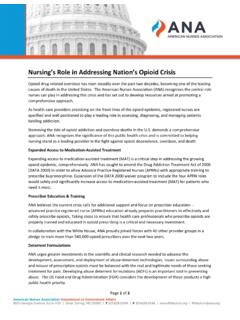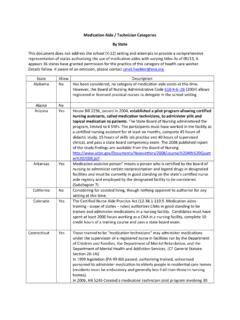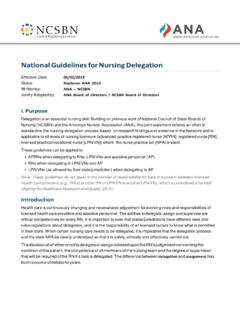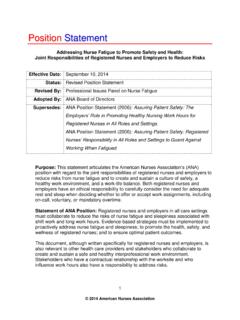Transcription of Promoting Patient-Centered Team-Based Health Care
1 8515 Georgia Avenue, Suite 400 Silver Spring, MD 20910 Promoting Patient-Centered Team-Based Health care Effective Date: 2016 Overview The United States spends more on Health care than any other country, and the outcomes are not representative of that investment. It is evident that the current Health care infrastructure is insufficient to meet the needs of Health care consumers today and in the future. A fundamental change in Health care delivery is needed to achieve what the Institute for Healthcare Improvement describes as the Triple Aim : Improving the patient experience of care (including quality and satisfaction); Improving the Health of populations; and Reducing the per capita cost of Health care (Berwick et al.)
2 , 2008). The high-performing team is now widely recognized as an essential tool for constructing a more Patient-Centered , coordinated, and effective system of Health care delivery (Mitchell et al., 2012). The American Nurses Association (ANA) supports the use of patient-focused Health care teams composed of various Health care professionals with unique abilities, training, and expertise. Defining Team-Based Health care The Institute of Medicine (IOM) defines Team-Based care as the provision of Health services to individuals, families, and/or communities by at least two healthcare providers who work collaboratively with patients and their caregivers to the extent preferred by each patient to accomplish shared goals within and across settings to achieve coordinated high-quality care (Mitchell et al.
3 , 2012, p. 5). Team-Based care offers many potential advantages, including expanded access to care (more hours of coverage, shorter wait times); more effective and efficient delivery of additional services that are essential to high-quality care , such as patient education, behavioral Health services, self-management support, and care coordination; increased job satisfaction; and an environment in which all medical and nonmedical professionals are encouraged to perform work that is matched to their abilities. Fundamental to this approach is the belief that when practices draw on the expertise of a variety of provider- team members, patients are more likely to get the care they need. A large provider team might also support continuous, data-driven quality improvement through effective intra- team communication and problem solving (AHRQ, 8515 Georgia Avenue, Suite 400 Silver Spring, MD 20910 Page | 2 Promoting Patient-Centered Team-Based Health care 2016).
4 Nursing has a particularly important role to play in defining care coordination, which has always been a primary duty of nursing (Lamb, 2014). Shared Values and Principles Each team is unique based on the setting or situation, but the IOM describes core shared values and principles that embody teamness and are critical to high-functioning teams (IOM, 2010, p. 6). In applying the core principles for true collaboration, team members values must align. Specific values reported include honesty, discipline, humility, creativity, and curiosity, and these values are interwoven through the principles of shared goals, clear roles, mutual trust, effective communication, and measureable processes and outcomes.
5 Shared goals: The team including the patient and, where appropriate, family members or other support persons works to establish shared goals that reflect patient and family priorities and can be clearly articulated, understood, and supported by all team members. Inherent in shared goals is humility among team members, as evidenced by accepting and celebrating the roles of the various other Health care disciplines and the central role of the patient. Subscribing to this value demands that no team member fundamentally believes that he or she is superior to another. Clear roles: Because professional responsibilities and duties may overlap, it is especially important that clear expectations be identified for each team member s functions, responsibilities, and accountabilities, and that discipline be used in meeting these expectations, thus optimizing the team s efficiency and effectiveness.
6 Mutual trust: When team members value honesty, trust can be earned. Thus, strong norms of collaboration and opportunities for shared achievement can be attained. Effective communication: The team needs to prioritize and continuously refine its communication skills. The team should have consistent channels for candid and complete communication that are accessed and used by all team members across all settings. Measurable processes and outcomes: Creativity and curiosity are paramount in Team-Based care , allowing team members to seek out new ways of solving problems, learn from poor outcomes, and commit to continual improvement of the team s practice. The team must agree on and implement reliable and timely feedback on successes and failures in both the functioning of the team and the achievement of the team s goals.
7 These factors can be used to track and improve performance immediately and over time (Mitchell et al., 2012). team Composition In an increasingly complex Health care system, no single team member can perform every task that the patient needs. Access to a diverse team that maximizes the unique expertise and insights of team members fosters the delivery of optimal care . Therefore, the expanded Health care team pulls from a variety of disciplines and may include registered nurses, advanced practice registered nurses (APRNs), physicians, physician assistants, pharmacists, physical therapists, occupational therapists, speech therapists, dieticians, certified nurses aides, social workers, psychologists, and even community support systems and other allied Health disciplines.
8 Although it is sometimes easy to differentiate among Health care professionals, occasionally the lines are blurred and duties overlap. This is often the situation with regard to physicians and APRNs. It is not realistic or cost effective to draw distinct lines between the duties of all Health care professionals. As APRNs have grown in number and visibility, the legal and regulatory framework for nursing practice has developed and 8515 Georgia Avenue, Suite 400 Silver Spring, MD 20910 Page | 3 Promoting Patient-Centered Team-Based Health care evolved. In the case of advanced practice nursing, nurses are able to perform certain components of care that were traditionally the province of medicine, including diagnosis and pharmacotherapy.
9 When providers work together in a team , outcomes are much improved over the work of just one person (Mitchell et al., 2012). And as in any team , success can be largely attributed to the leadership. The leader embraces the team values and fosters coordination and collaboration among the team members with a continued focus on the patient-consumer. Although there is support for this new delivery model, it comes with challenges. Challenges in Implementing Team-Based care In making sense of the current controversy, it is helpful to make a distinction between Team-Based care as a model for delivering care and individual licensure authority. Team-Based care is a delivery model where patient care needs are addressed as coordinated efforts among multiple Health care providers and across settings of care .
10 Licensure is the legal recognition and permission of one individual to provide professional services to patients . patients The most important team member is the patient. Not all patients are comfortable being much more active participants in Health care decisions. This can be compounded by an orientation to the use of a single provider for multiple episodes of care . Although the situation is changing, that single provider has historically been a physician. APRNs are not interested in replacing physicians but rather in practicing in a manner consistent with their education and training, thus permitting physicians to focus on patients with more complex needs. When the knowledge and skill of all team members is used optimally, patients will find that their care is being delivered by the most appropriate team member.
















